Wadi Ghub, most commonly known as the Rainbow or Spectrum Valley hike, is one of the most unique locations in the United Arab Emirates, and is Instagram-famous for good reason.
Amongst the rocky cliffs of the Hajar Mountain Range, the Rainbow Valley emerges slowly, before enveloping you in a sweeping wave of color. This colorful valley is formed by layers of multicolored rocks, winding their way through the wadi in an effect that truly transports you to another planet.
Wadi Ghub is a great day trip from the big cities in the UAE for novice and seasoned hikers alike. Located in the Emirate of Fujairah, under two hours from Dubai, the Rainbow Valley offers hikers the option to customize their route and experience, or simply a break from desert landscapes.
Novice hikers looking for the insta-worthy shot will find the 2 mile (round-trip) hike to the famed spectrum fairly simple. More experienced hikers can continue the hike into the wadi, turning the hike into a longer excursion of 5 to 8 miles roundtrip. Adventurers attempting the longest trek will even get a mountaintop view of neighboring Oman.
This guide breaks down everything you need to know — from travel conditions en route to Wadi Ghub to the exact place to leave your car (or pitch your tent!) Keep reading to plan your trip to Fujeirah’s Rainbow Valley.
This site uses affiliate links to share products that I use and love! If you click on one of the links I may receive a small commission at no additional cost to you. This helps keep my site up and running — thank you!
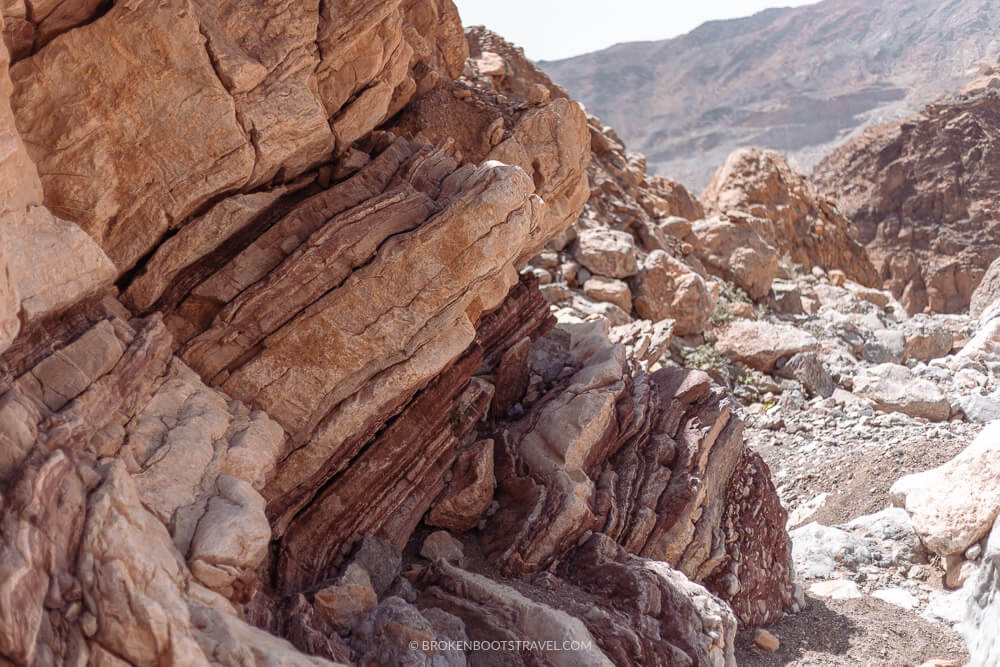
The Rainbow Valley Basics
Total Distance: 2 miles/3.2 km (Beginner), 5 miles/8 km (Moderate), 8.3 miles/13 km (Advanced)
Duration: 1-1.5 hours (Beginner), 2-4 hours (Moderate), 6-8 hours (Advanced)
Difficulty level: Beginner, Moderate, and Advanced options
Location: In the Emirate of Fujeirah, approximately 1 hour and 45 minutes from Dubai | Click here to view on Google Maps
Cost: Free
Know Before You Go
Before you hit the road to the Rainbow Valley, Fujeirah, here are a few things you should know.
The Geologic Wonder of Wadi Ghub
Wadi Ghub is a geological wonder, formed by millions of years of compacted sand, wind, and water erosion. The layered effect essentially captures a wave in stone–revealing millions of years of geological history in its layers of sandstone.
Each layer provides a unique look into the geologic timeline of the region, painting a picture of the rainfall, wildlife, and landscapes that formed the UAE millions of years ago.
Recommended Reading: Hiking Fossil Rock, Sharjah: The Best UAE Hike for Geology-Lovers
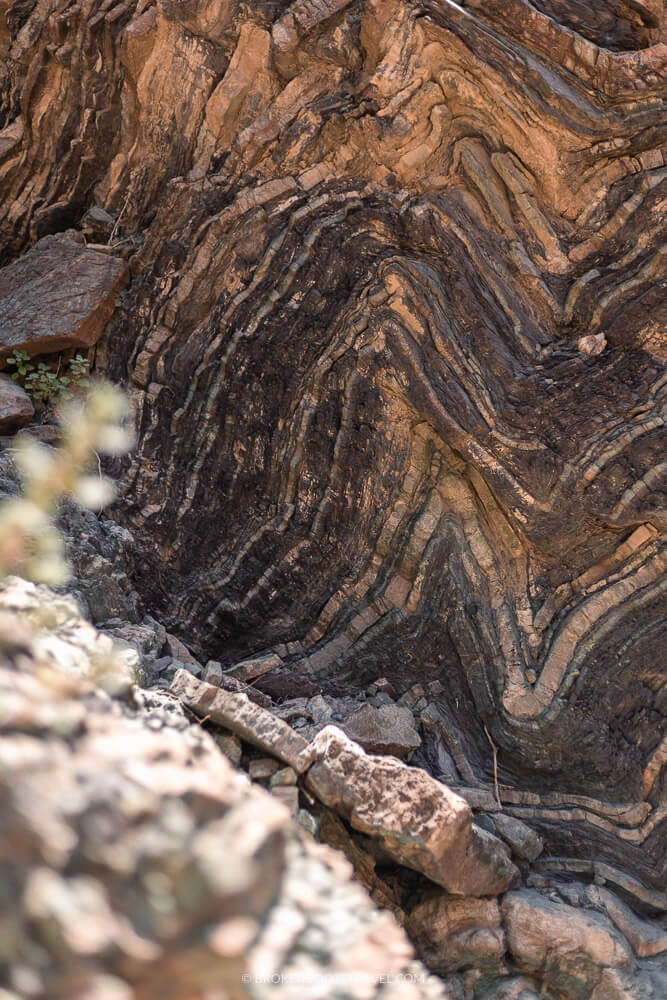
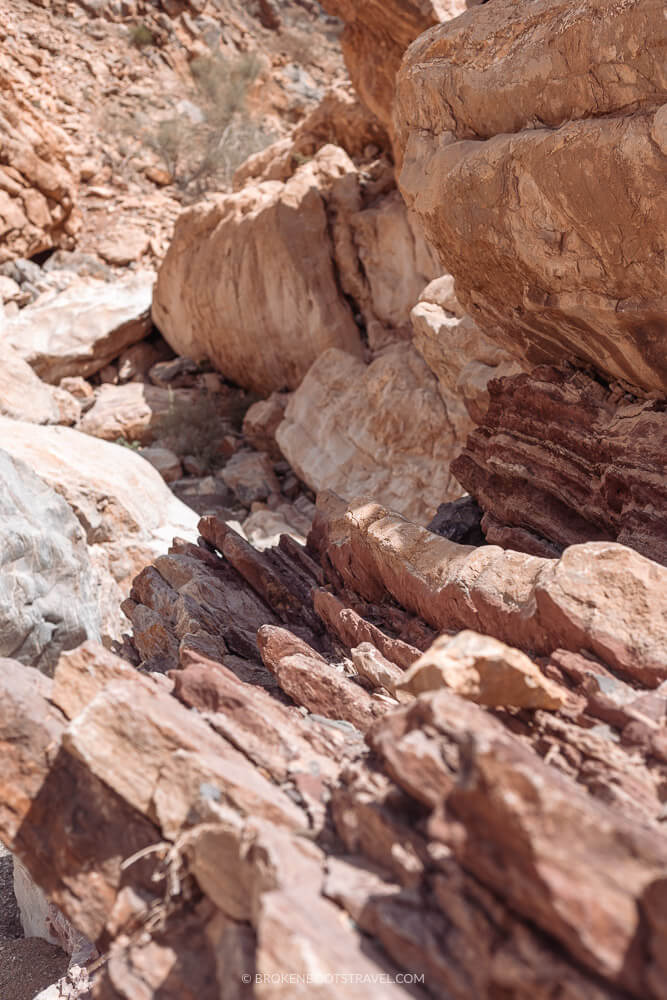
Be Aware of Wadi Safety
A wadi is an Arabic word referring to a dry ravine, a natural feature common to many arid, desert landscapes in the Middle East. Wadis are often dry riverbeds, meaning they sometimes see water in the cooler seasons.
This can be a hazard for flash floods, so while you rarely ever see a cloud in the UAE, rethink your plans if you happen to choose the one rainy day of the year.
Watch out for Mountain Goats
No–seriously! When we hiked Wadi Ghub, we were followed by a rather vicious mountain goat who tried to steal my peanut butter sandwich multiple times.
I’d recommend keeping your food in a sealed container to keep away unwanted visitors and keeping an eye out for wandering goats when taking snack breaks. Just a reminder–these goats can climb, so your PB&J won’t be safe even on the ridge line!

The Best Time to Hike Wadi Ghub
The best season for hiking in the UAE is during the winter, when temperatures are cooler. The best months for hiking are between October and March. Regardless of the season, I recommend getting to the trailhead early when the climate is cooler.
Regardless of the season, Wadi Ghub is a fairly exposed hike without much shade protection. Heat stroke is a real issue in the UAE – temperatures can reach upwards of 40 degrees in the summer months! Take the heat seriously and pack sufficient water and sun protection.
Keep in mind that due to its proximity to the equator, the sun sets nearly daily around 6:30PM year round. Unless you plan to camp in the wadi, I recommend getting an early start of the Rainbow Valley hike to maximize sunlight.
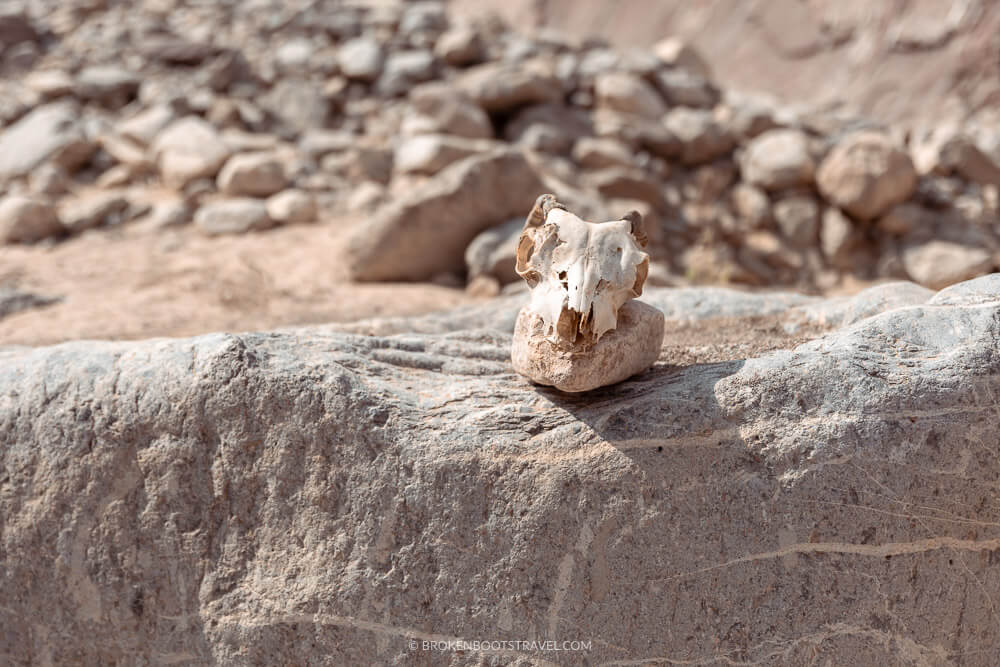
How to Get to the Rainbow Valley, Fujairah
There is no public transportation to Wadi Ghub, so a car is essential for this hike. If you’re visiting the UAE, I highly recommend renting a car to take advantage of off-the-beaten path adventures. I use RentalCars.com for car rentals around the world.
You do not need 4WD to visit Wadi Ghub. The trailhead begins just outside the village of Ghub, down an unpaved but well-worn road. The road is easily accessible without 4WD, but if you’re nervous you can leave your car in the town of Ghub and walk to the trailhead, adding about 1km to your trip each direction.
From Dubai, take route E11 for 94km until it connects with Al Shuhada Road. Take Al Shuhada Road for 54km until you arrive in the town of Ghub. From Ghub, take the well-worn road outside of town to the Rainbow Valley parking area. You can view the exact location on Google maps here.
Recommended Reading: The Best Things to do in Mleiha – The UAE’s Archaeological Hub
How to Hike Wadi Ghub: The 3 Main Routes
Wadi Ghub has routes for all hiking abilities. The famous Rainbow Valley is a fairly easy 2 mile hike, but if you’re a more experienced hiker, don’t discredit hiking further into the wadi for more spectacular mountain views. However, be aware that all three routes, regardless of length, include quite a bit of bouldering and rocky terrain. Here are three main routes to take through Wadi Ghub.
Route 1: Beginner Hike – 2 miles/3.2 km
This is by far the most popular of the Rainbow Valley vikes. A short trek, ending with the spectacular Spectrum Valley formation, is perfect for those new to hiking or simply craving a straightforward and beautiful route.
Beginning where you parked your car, continue walking up the road. You’ll soon spot a cellphone tower in the distance. The trail will take you uphill past the cellphone tower where you will enter the wadi.
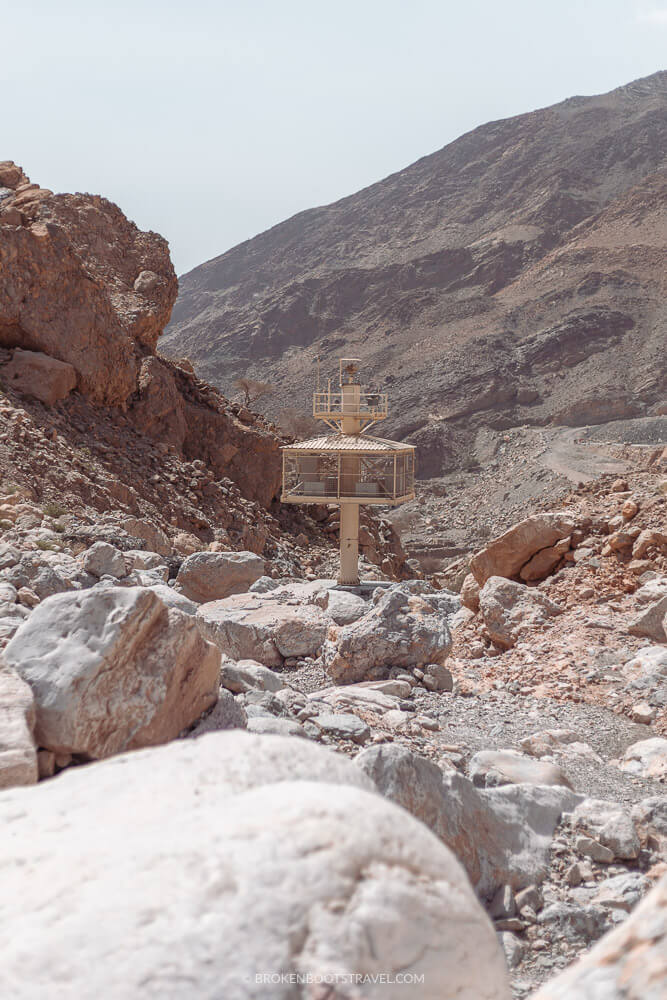
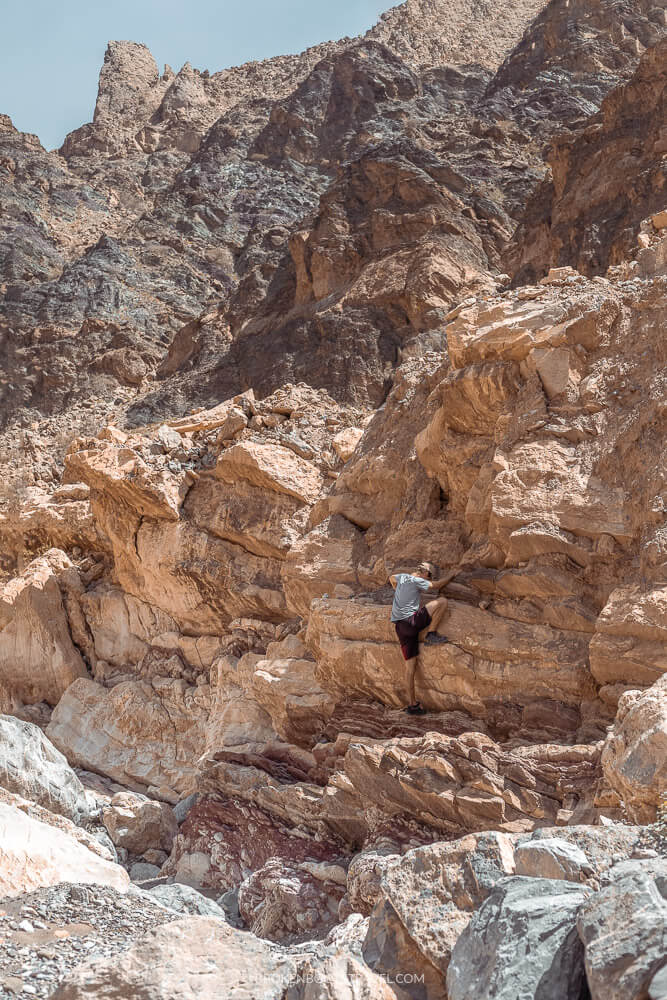
Once you reach the cellphone tower, continue through the wadi. There is a gravel path along the right side, which I recommend for the easiest hike. Those who feel comfortable can walk off the path to check out some of the large boulders in the wadi — keep an eye out for creatures hiding in the crevices! My partner Thomas has recently gotten into bouldering, so there are lots of spots along this part of the hike perfect for climbing.
The most photographed Rainbow Valley spot is located only 1 mile from the trailhead. It is best accessed by sticking to the gravel path on the right. Here you will see the famous layers of colored rocks, sweeping around a small pool of water. The water is not suitable for drinking or swimming, but it is beautiful nonetheless.
Here you can explore the beautiful spectrum formation. The best way to reach the top of the valley is via the right side of the formation. It requires a bit of bouldering, but the trail continues along the side, leading to a photogenic spot overlooking the spectrum formation and the valley below. This is a great spot to stop and take a break before turning around and returning the way you came.
Recommended Reading: Hiking the Hatta Sign: The Best Beginner Hike in the UAE
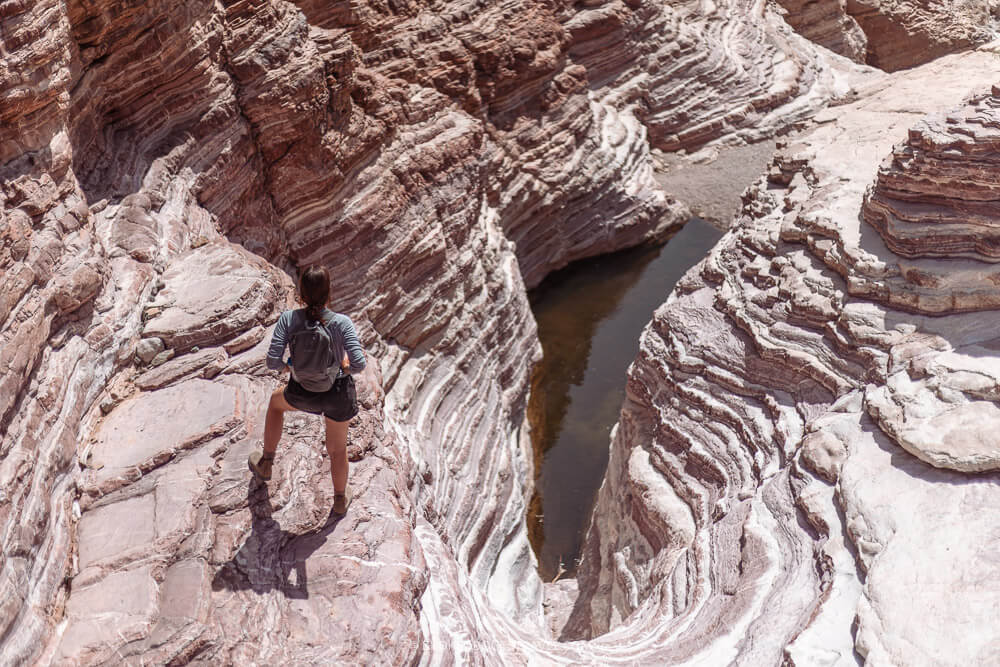
Route 2: Moderate Hike – 5 Miles/8 KM
The second part of this hike is equally as beautiful as the spectrum formation, but much less explored. The trail itself is fairly straightforward, continuing through the wadi in the Rainbow Valley.
From the Spectrum formation, continue deeper into the wadi. There is plenty of bouldering required in this section, so be prepared to use both your arms and legs to navigate this trial. Luckily, the direction you need to go continues to be well marked.
While there is no gravel trail like in the first section of this hike, it’s hard to get lost within the wadi. To ensure you’re heading the right direction, keep an eye out for stacked rocks (called cairns) marking the trail.
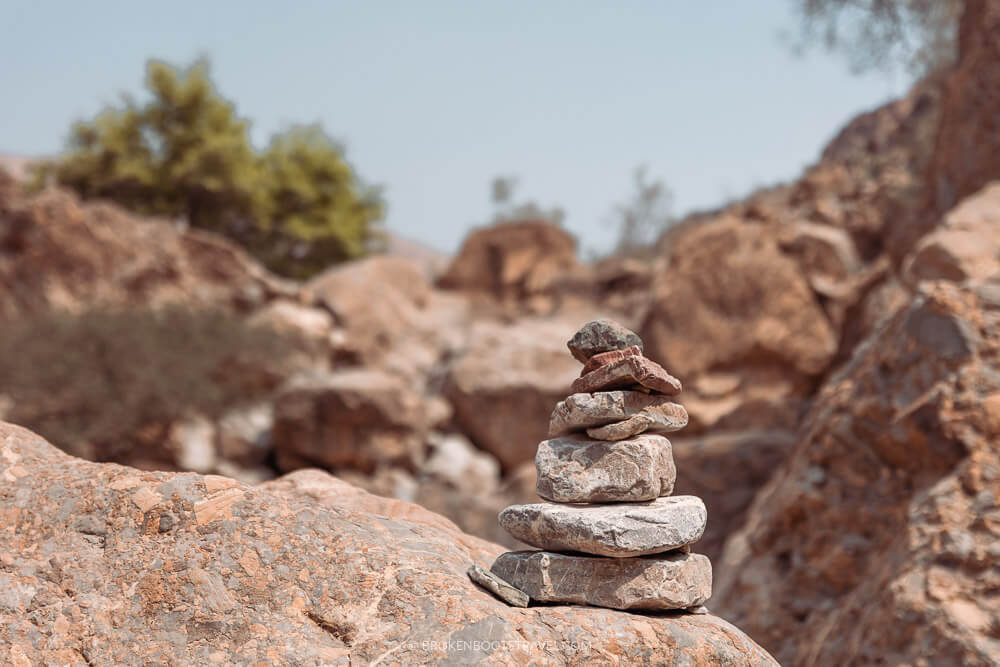
Because of the technicality of this section, it moves at a slower pace than the first section of the hike. However, the rainbow rock formations continue and you’ll feel like you’re on another planet as you wander through the valley. My favorite part was a deep canyon we encountered about 2km from the famous Instagram spot with a similarly beautiful rainbow formation but much less visited.
You’ll know that you’re reaching the end of this section when you notice the landscape start to change. You will notice less rainbow rocks and more scree, and the trail will widen up with the mountains in the distance. If you’re planning to camp, this flatter landscape is the perfect spot.
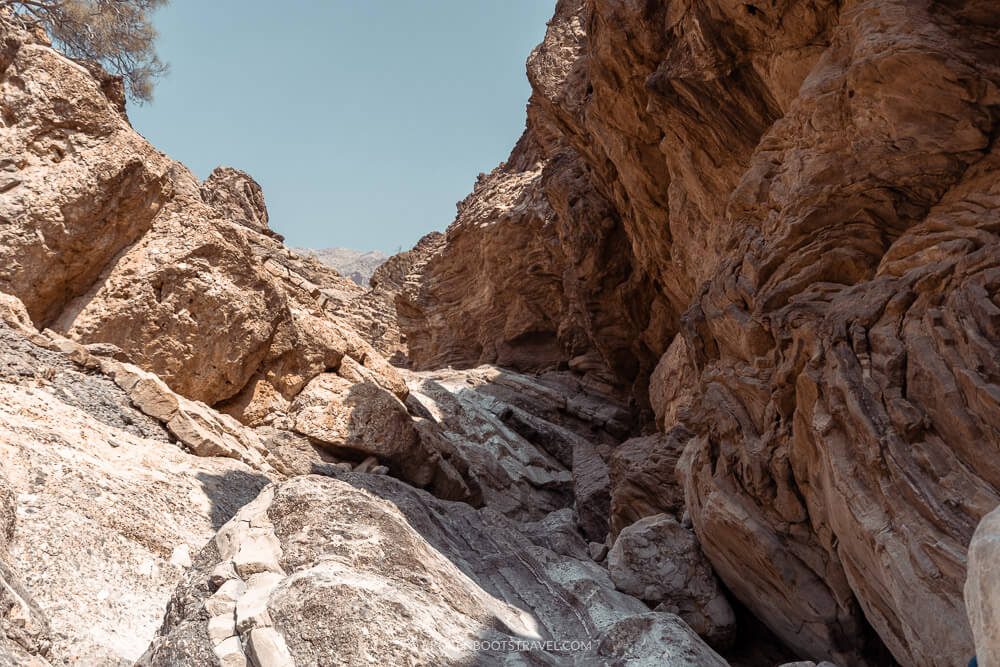
Route 3: Difficult Hike – 8.3 miles/13 km
The final section of the Rainbow Valley is the most difficult of the three sections, mainly due to elevation as you summit the ridgeline of the wadi. This part of the trail is not nearly as well marked, and we noticed hikers summiting a variety of different peaks around the area.
Length is not the challenge here, steepness is. I’d only recommend this route to truly experienced hikers — the trail is not clear and it requires a lot of steep uphill climbing over loose rocks and scree. At many instances you’ll need to make your own path, so only attempt this if you feel confident doing so. The landscape is different from the rainbow spectrums, but is still equally as beautiful with the jagged rocks emerging from among the mountain peaks.
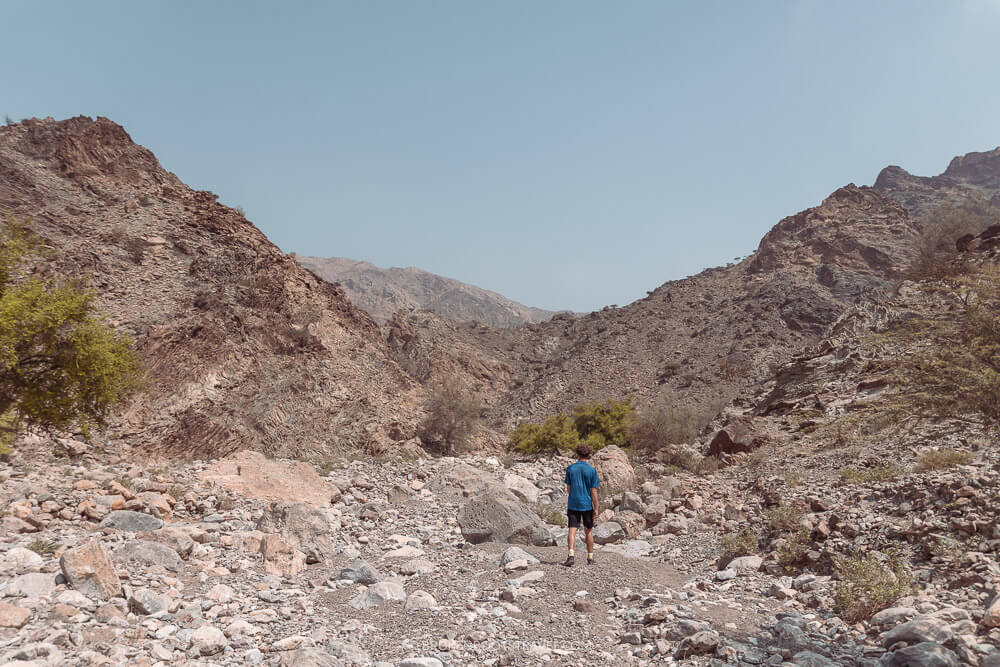
There’s no exact rule as to when to stop, but before long you’ll crest a peak and be rewarded with sweeping views of the mountain range and a look into neighboring Oman. Make sure to look back the way you came though — the rainbow spectrums look even more spectacular from above!
We opted to explore along the ridge line for a little bit before heading back the way we came. However, if you’re really looking for a challenge, you can continue deeper into the wadi. Just make sure you know where you’re going and pack plenty of water — even during the cooler parts of the year, this hike will work up a sweat!
Recommended Reading: Hiking The Stairway Heaven – The UAE’s Most Difficult Hike
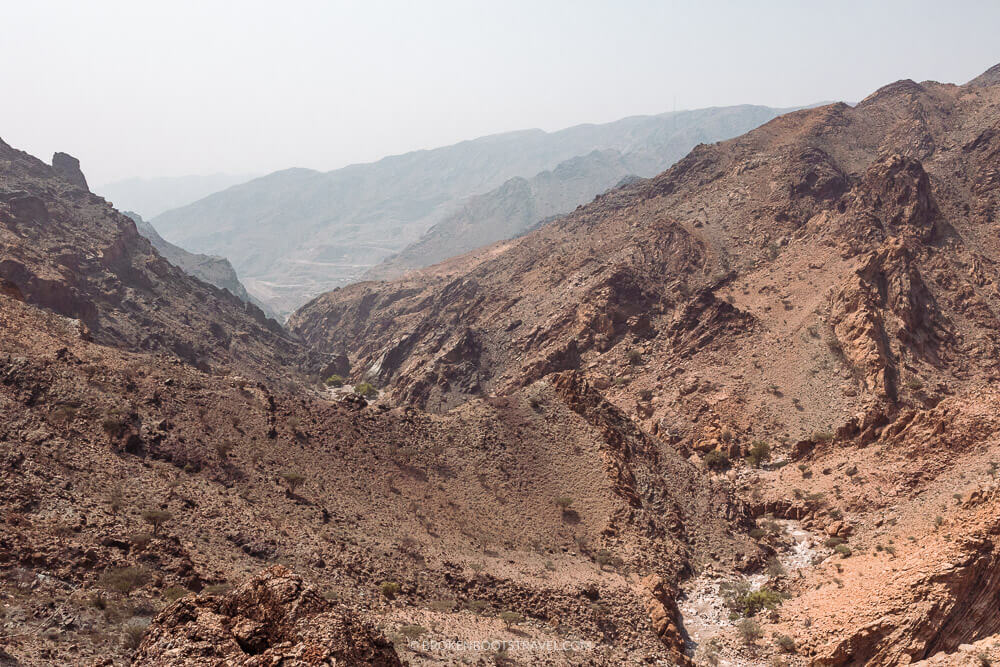
What to Bring to Hike the Rainbow Valley
Hiking in the UAE often puts visitors outside of the major cities and into smaller villages. You may find yourself interacting with local villagers, so remember to be kind and respectful in your interactions. Rural areas also tend to be more conservative than the larger cities, so I recommend keeping your shoulders and knees covered when out hiking.
Here are a few more of my tried-and-true essentials for hiking the Rainbow Valley Trail.
- Hiking Boots: I find my Blundstone Boots perfect for UAE hiking and city exploring.
- Lightweight Scarves: Perfect for a little extra sun protection or modesty in a smaller town.
- Purifying Water Bottle: Water is a precious resource in the desert so let’s make the most of it and save plastic in the process.
- Water Bladder: You’ll need more water than you think! This portable water bladder makes it easy to carry it all on your back.
- Camera daypack: I take this small camera bag with me EVERYWHERE, perfect for both my camera and daily essentials!
- SPF: A must when hiking in the UAE, SPF 50 or higher if possible
- The Wikiloc App: If you’re heading out on a UAE hike, there’s no better app than Wikiloc! Download routes, share photos with other hikers, and stay safe out on the trails.

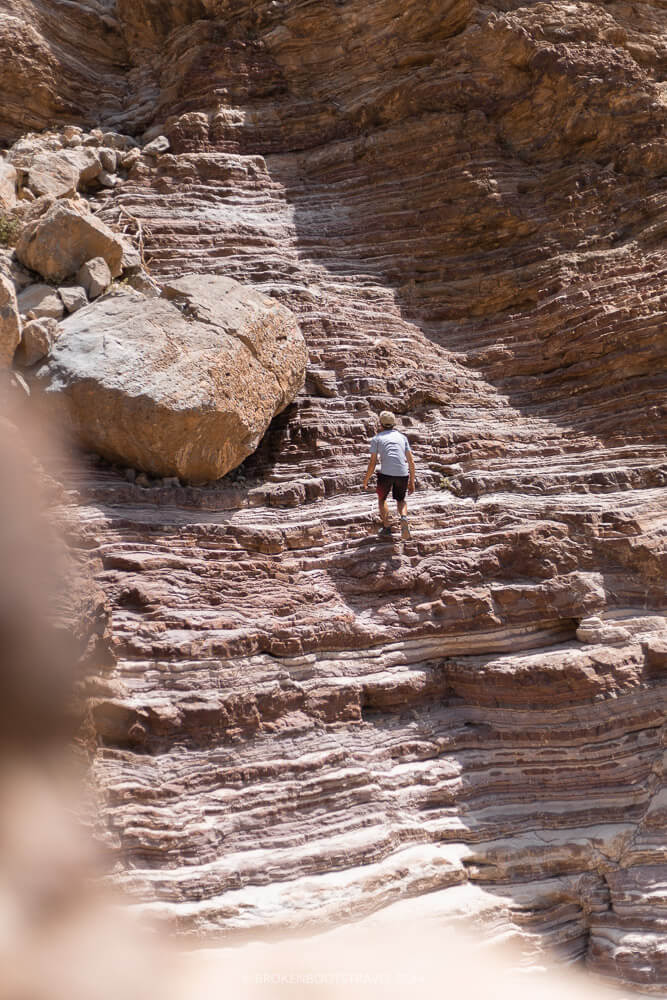
Tips for Camping in the Rainbow Valley
Camping in Fujairah’s Rainbow Valley certainly won’t put you at a loss for beautiful views, but you may struggle to find a flat spot to pitch your tent!
I recommend the flatter, rockier area right after the second section of this hike as it is the perfect mix of isolated and beautiful. Alternatively, the ground is relatively flat early in the first section, but being at the beginning of the hike you may have the company of fellow hikers.
Camping is legal in rural areas of the UAE, but do come prepared and prepped to camp in a way that is safe for both you and the environment. Littering is illegal in the UAE, so make sure to pack any trash to take with you. Additionally, if you plan to have a campfire, you must make sure it is contained to prevent wildfires.
Recommended Reading: Camping in Oman – The Ultimate Guide from a Solo Female Traveler
The Petroglyphs in Wadi Ghub
If you’ve been researching Wadi Ghub, you may have stumbled upon scarce resources talking about the petroglyphs located in Wadi Ghub, dating back to the Iron Age. These petroglyphs are accessible by hiking in the Wadi, but are not a part of the trail most often followed for the Rainbow Valley hike. These petroglyphs are located in Wadi Ghub, but are most easily accessed via the nearby town of Al Taween.


Why Hike Wadi Ghub?
If you’ve been craving a city break, look no further than the Martian-esque landscapes of Wadi Ghub. Perfect for hiking newbies and nature lovers alike, pack your water, grab your trekking shoes, and go befriend some mountain goats in Fujeirah’s beautiful Rainbow Valley.
Looking for more unique adventures in the UAE? Check out Shark Island, the best snorkeling spot in the UAE, or get to know Emirati Camel Culture through a Camel Beauty Pageant or Camel Race. Even if you’re staying in Dubai, there’s plenty of culture to see in the heart of the city itself.
Wherever you decide to explore, you’re certain to find plenty of unique adventures off the beaten trail in the UAE.
UAE Quick Links
✈️ Flights – Use Kiwi.com or WayAway to find the cheapest and fastest flights to the UAE
🛏️ Accommodation – Find the best places to stay throughout the UAE on Booking.com
✅ Get Insured – I personally use Safety Wing Nomad Insurance for my travels all around the world! VisitorsCoverage is another great option.
🚗 Rent a Car – Find the best deals for a UAE road trip on RentalCars.com
🗺️ Find Things to Do – Check out Get Your Guide or Viator for exciting adventures all around Kenya☎ Buy a Sim – Airalo offers eSIMS for over 200 countries and regions
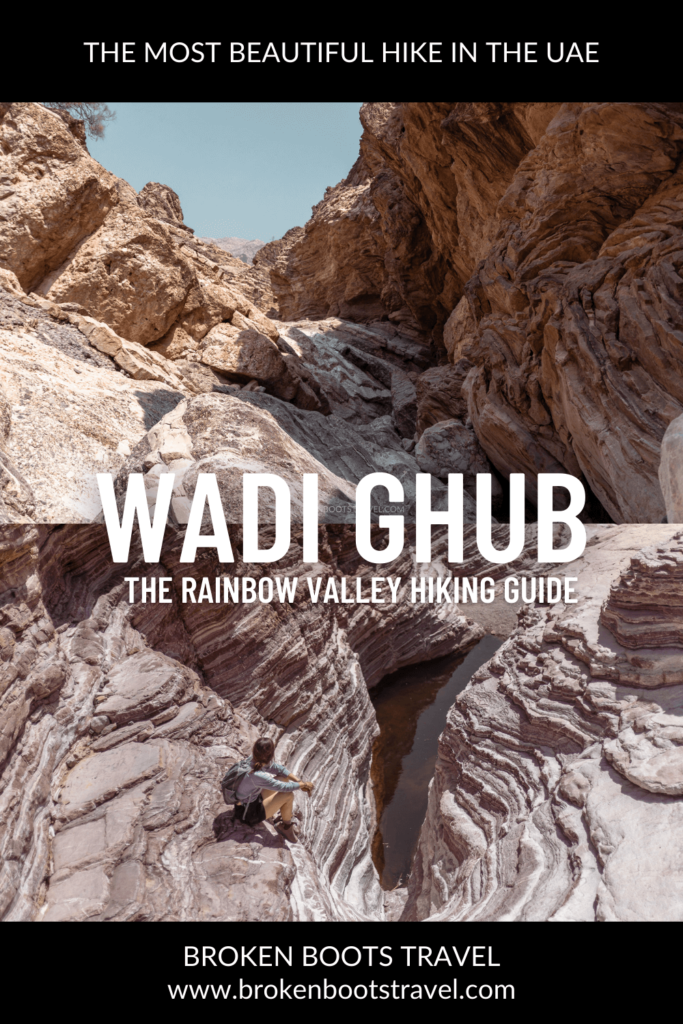


Love stories? Subscribe to my newsletter to get my latest updates delivered straight to your inbox every month. One email a month + no spam? Sign me up!
Virginia Taylor (Ginna) is a travel writer and photographer exploring the world until her boots wear through. She’s currently on a mission to explore all 32 departments of Colombia, though she formerly called the Middle East home. Want to know more? Visit the About Page.
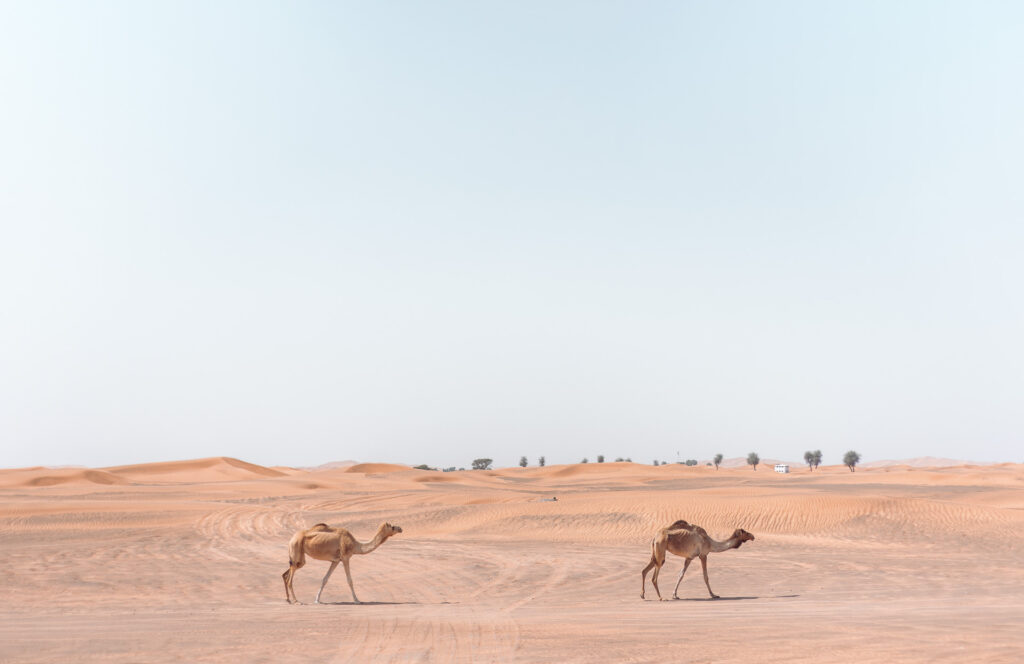
This is fascinating! I know so little about this area and its offerings, but I learned a ton with this post!
It was so surprising to me to learn there were so many outdoor things to do in the UAE! It’s now one of my favorite places to explore in the world, I hope you get a chance to visit some day! 🙂
Wow! I can’t get past the rock formation! I have never thought about hiking in the UAE, but there are many great hiking options. It would be great if there were tours taking people who cannot drive there. Thanks for sharing.
I know right–I had no idea there were even mountains in the UAE before I moved here! Tours would be awesome–maybe I’ll think about taking some fellow trekkers out there some day! 🙂
Awesome tips! Pretty sure I’d end up on the beginner route, but would love to check them all out. Your photos are stunning!
Thank you so much!! The beginner route was no easy feat so I feel you!
This reminds me of hiking through the Sinai desert, but not quite, although the climate must be similar. Love the rock formations. I would spend more time looking at them than hiking!
I totally feel you, I spent longer looking at (and photographing) the rocks than I did hiking!
What a great place to hike! It reminds me very much of where we used to live and hike in California — the Mojave Desert!
Ohhh, I’ve always wanted to visit the Mojave Desert! I’ll definitely have to go some day!
This is amazing! I’m going back to Dubai next week and I’m dying to try this out!
Omg, welcome back to Dubai!! Feel free to shoot me an email if you need any help while you’re here, I know you’ll have a great trip!
Wow! Looks amazing! I loved how you wrote this article and included maps for the hikes! Going to add this to the bucket list!
Such a great in-depth and informative article on how to hike the RAINBOW VALLEY in Fujeirah! While I’ve visited Dubai and Abu Dhabi, I would love to visit the other emirates as well.
Pingback: Hiking the Hatta Sign - A Guide to Dubai’s Best Beginner Hike
Pingback: Hiking in Fujairah: Exploring the UAE's Hidden Trails - Beyond Whispers